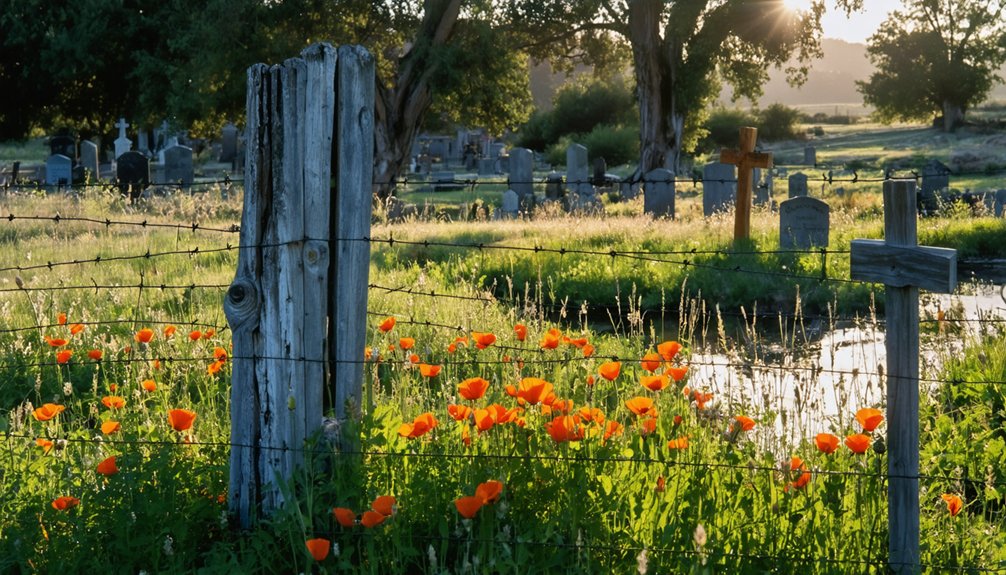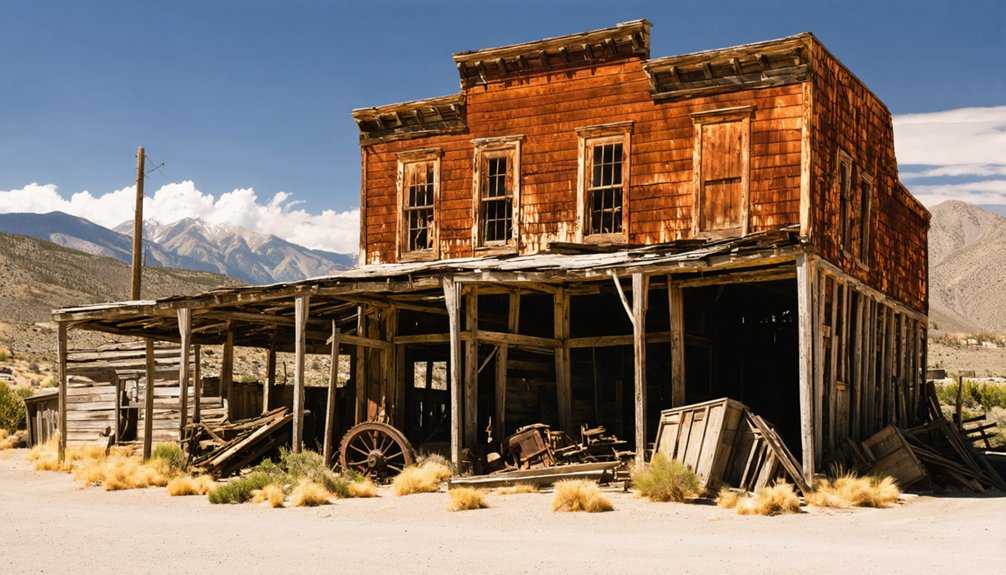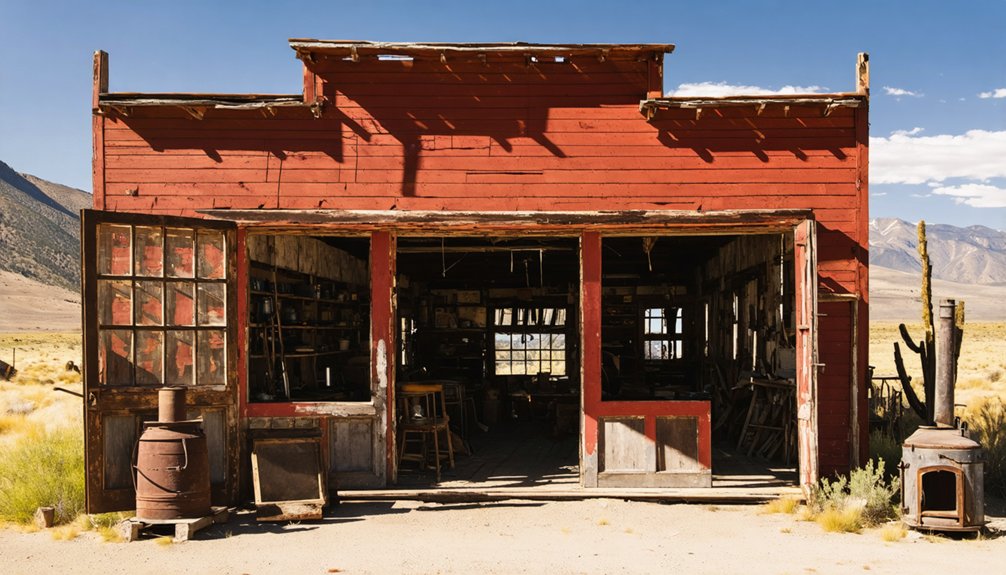You’ll find Coleman City nestled in Julian’s golden hills, a ghost town born after freed slave A.E. “Fred” Coleman’s 1869 gold discovery. This tent settlement, briefly called Emily City, swelled to 800 prospectors before fading within months as miners pursued richer claims nearby. At 3,601 feet elevation, harsh weather challenged these early settlers who used primitive sluice boxes and pans. This forgotten chapter in California’s mining heritage holds surprising stories beneath its vanished streets.
Key Takeaways
- Coleman City was founded after A.E. “Fred” Coleman’s 1869 gold discovery, quickly attracting over 800 prospectors to the Julian area.
- Initially named Emily City, the settlement was renamed Coleman City to honor Fred Coleman, a former slave who organized the mining district.
- The boomtown featured primitive living conditions with canvas shelters, minimal sanitation, and diverse miners using placer mining techniques.
- Coleman City declined within months as placer deposits diminished, with miners migrating to more profitable lode discoveries in nearby Julian.
- Now a ghost town, Coleman City exemplifies the transient nature of California mining settlements while preserving an important chapter in post-Civil War mining history.
The Gold Discovery of A.E. Coleman
When you wander along what’s now known as Coleman Creek, you’re treading on the very soil where California’s gold mining history took a significant turn.
It was here, in the winter of 1869, that A.E. “Fred” Coleman—a former slave working as a cattle herder—spotted golden flecks glistening in the water while his horse drank.
Coleman’s discovery sparked immediate community impact, transforming Julian from a quiet settlement into a bustling tent city almost overnight.
Over 800 prospectors flocked to the area within weeks, necessitating mining regulations that Coleman himself helped enforce as the elected recorder of the Coleman Mining District.
His find didn’t just unearth precious metal—it established Julian’s economic foundation and created a legacy that continues to echo through the region’s history.
Fred lived in Julian with his Kumeyaay wife, Marian and their eleven children while working as a cattle herder in the area.
Coleman’s experience in the gold fields of Northern California had prepared him to recognize the valuable mineral when he encountered it in the creek.
From Emily City to Coleman City: The Founding Story
You’ll find the settlement originally christened as Emily City in early 1870 quickly burgeoned from 75 miners to approximately 150 within a single month.
A.E. Coleman, who organized the Coleman Mining District and served as its recorder, lent his name to the settlement when it shifted from Emily City to Coleman City.
Among the diverse population drawn to this budding mining community was Fred Coleman, an African American pioneer who’d already settled in the area with his Kumeyaay wife before the gold rush transformed the region’s demographic landscape. Fred’s gold discovery in a stream at Calico Rancho was the catalyst that launched Julian’s historic gold rush in 1869.
Despite initial skepticism from authorities, Fred Coleman’s discovery of small gold nuggets, which he washed out using a pan, eventually led to significant excitement and a stampede of prospectors to the region.
A.E. Coleman’s Gold Discovery
The remarkable story of Coleman City begins with a single, fateful moment in the winter of 1869-70, when A.E. “Fred” Coleman—a former enslaved man who’d gained valuable experience in Northern California’s gold fields—noticed glittering flakes in a stream while watering his horse near Spencer Valley.
Coleman’s discovery transformed this quiet corner of San Diego County:
- He immediately confirmed his find by panning, extracting $2-$3 daily.
- News spread rapidly, attracting scores of miners to the area.
- Coleman was elected recorder of the newly formed mining district.
- The settlement, initially called Emily City, was renamed Coleman City in his honor.
Living with his Kumeyaay wife Maria and their children, Coleman’s legacy became permanently etched in the region’s history, laying foundation for a diverse mining community that would briefly flourish along the creek bearing his name. The area had already established a Black and Indian settlement prior to the gold rush that would transform the region’s demographic makeup. His discovery came shortly after a severe rainy season that had caused significant flooding across the West Coast in 1869.
Rapid Settlement Growth
Following A.E. Coleman’s January 1870 gold discovery, what began as Emily City transformed almost overnight.
Within weeks, over 800 prospectors flooded the area, drawn by the promise of placer gold along Coleman Creek. By February, the mining community housed 75 determined souls, swelling to 150 by March.
You’d have found a rugged settlement at 3,601 feet elevation, where tents dotted the landscape and many miners simply slept under the stars.
The settler demographics reflected the diverse backgrounds typical of gold rush boomtowns, though the population remained mainly male.
As the Coleman Mining District formalized, with Coleman himself serving as its first recorder, the settlement adopted his name.
This change from Emily City to Coleman City marked the brief but vibrant birth of another California dream—one that wouldn’t last.
African American Mining Pioneer
One remarkable figure stood at the center of Coleman City’s founding story: Fred Coleman, a Kentucky-born freedman whose keen eye for gold transformed the region’s destiny.
Already established in the area by 1863, Coleman lived with his Kumeyaay wife and children, expertly blending his ranching skills with his Northern California mining experience.
When he spotted gold in a creek during the winter of 1869-70, his discovery ignited a rush that would forever alter the landscape:
- 800+ prospectors flocked to the area within weeks
- The Coleman Mining District formed with Fred as its first recorder
- African American pioneers comprised about 7% of Julian’s population by 1890
- Coleman’s legacy lives on in place names throughout the region
This freedman’s discovery cemented African American contributions to California’s mining heritage forever. Coleman demonstrated his entrepreneurial spirit by constructing toll roads between El Cajon and Coleman City as a business venture.
Life in a Tent Mining Community
While gold fever drove prospectors to Coleman City in droves, daily life in these canvas settlements revealed humanity’s remarkable adaptability to harsh frontier conditions.
Gold fever revealed not just our hunger for wealth, but our astonishing ability to adapt and survive against frontier odds.
You’d have found yourself in cramped quarters, your canvas shelter mere inches from your neighbor’s, fostering community resilience through necessity.
Dawn-to-dusk mining left little leisure, yet cultural exchange flourished as Kumeyaay natives, African Americans, and European immigrants shared stories around evening fires.
Women like America Newton established essential services—laundries and boarding houses—that transformed transient camps into functioning societies.
Your daily challenges would’ve been formidable: outdoor cooking regardless of weather, minimal sanitation, and the constant threat of illness.
Yet this crucible of hardship forged lasting bonds, as miners banded together against nature’s whims, creating community from chaos.
The settlement was established after A.E. Fred Coleman, a former slave, discovered gold near Coleman Creek in 1869, sparking the formation of the Coleman Mining District.
The Kumeyaay people played a vital role in the community’s development by helping create essential roads connecting the mining settlement to Santa Ysabel.
Gold Mining Methods and Challenges

If you’d visited Coleman City during its brief heyday, you’d have seen miners hunched over pans and sluice boxes along Coleman Creek, swirling sediment in a patient search for gold flakes among the gravel.
Your success at extracting precious metal would have depended on primitive tools—pans, picks, shovels, and wooden sluices—that limited how much material you could process daily.
Winter’s grip at 3,601 feet elevation transformed your mining routine, freezing creek waters and forcing adaptations to harsh conditions that often halted operations entirely.
The discovery by A. E. Coleman in January 1870 sparked the initial rush that brought miners to this remote area.
Placer Mining Techniques
Throughout the dusty gold fields of Coleman City, prospectors employed ingenious placer mining techniques to separate precious gold from common earth. You’d witness men redirecting streams to expose gold-rich riverbeds, exploiting the metal’s remarkable density.
Water separation methods evolved from simple panning to elaborate sluice systems, each innovation granting freedom from backbreaking labor.
The most effective techniques included:
- Gravity concentration with sluice boxes where riffles trapped heavy gold
- Rocker cradles that agitated gravel while washing away lighter sediments
- Spiral chutes processing finer particles between 0.6-0.03mm
- “Stripping” operations removing barren overburden to reach gold-concentrated bedrock
Avoiding hazardous mercury amalgamation whenever possible, the discerning miner relied on water’s natural sorting power, letting gravity do what chemicals couldn’t—separate wealth from worthlessness without poisoning the land they treasured.
Primitive Equipment Limitations
The ingenious placer mining techniques employed in Coleman City faced significant obstacles in the form of rudimentary equipment that tested miners’ patience and physical endurance.
You’d find yourself laboring with primitive tools like wooden long-toms and simple sluice boxes that frequently clogged with sediment, requiring constant maintenance that ate away precious daylight hours.
Without electricity or steam power, you relied solely on your own strength or draft animals to process gold-bearing material.
Equipment durability was a persistent concern; wooden implements deteriorated quickly in harsh conditions, while metal components wore down with minimal replacement options in the remote settlement.
The gravity-dependent separation methods missed finer gold particles, leaving wealth behind in the tailings.
Limited by these constraints, you couldn’t process deep deposits or handle clay-bound gold that required more sophisticated extraction methods.
Harsh Weather Operations
Miners at Coleman City battled a punishing array of weather challenges that transformed their gold-seeking endeavors into grueling tests of endurance and adaptability.
Perched at 3,601 feet, you’d face bone-chilling winters and parched summers that demanded constant weather adaptation strategies for survival and productivity.
Your mining logistics would revolve around:
- Working creek claims during ideal water flow periods, using simple panning and sluicing techniques
- Protecting crude wooden equipment from destructive freeze-thaw cycles
- Traversing muddy, washed-out supply routes from Santa Ysabel during rainstorms
- Relying on Kumeyaay knowledge for terrain survival when conditions worsened
The harsh mountain climate shortened mining seasons and workdays, with temperature swings between day and night forcing you to adapt or abandon your golden dreams when Coleman Creek’s placers couldn’t justify enduring another brutal season.
The African American Heritage of Coleman Creek

When gold glittered in the waters of what would become Coleman Creek in 1869, it wasn’t just another California gold rush—it marked the beginning of a uniquely diverse settlement with deep African American roots.
Fred Coleman, a freed enslaved man from Kentucky with prior mining experience, made the discovery that would transform the region.
You’ll find extraordinary evidence of African American community resilience in Julian’s history. Before the town was officially established, Black settlers like Coleman had already created lives here.
Within weeks of his discovery, Coleman City boomed with 800 prospectors. Black entrepreneurs thrived—from the Robinson Hotel to America Newton’s successful laundry business.
Many intermarried with Kumeyaay people, including Coleman himself. By 1890, African Americans comprised 7% of Julian’s population, establishing businesses and social organizations when most of America still struggled with Reconstruction.
Decline and Abandonment of the Mining Camp
Unlike many California mining settlements that endured for years, Coleman City‘s golden promise flickered briefly, then faded into history’s shadows after only a few months of frenzied activity.
The community dynamics shifted rapidly as miners confronted diminishing returns from Coleman Creek’s depleted placer deposits.
By mid-1870, you would’ve witnessed the classic mining migration pattern that defined the era:
- Miners abandoning their claims for Julian’s richer lode discoveries
- No substantial infrastructure to anchor the population once gold fever subsided
- Transient workforce following whispers of better strikes elsewhere
- Absence of diversified economy to sustain the settlement
Without the deep-vein deposits that sustained Julian, Coleman City couldn’t evolve into industrial mining operations.
The settlement simply vanished, leaving only its name etched on local geography—a reminder of freedom’s fleeting nature.
Geographic Setting and Natural Environment

The landscape that once attracted prospectors to Coleman City still cradles the ghost town’s memory in its rocky embrace. Perched at 1,098 meters above sea level, you’ll find yourself surrounded by the rugged elevation features of the Cuyamaca Mountains foothills, where Coleman Creek carves its path along Highway 78.
The mountain climate influence creates distinct seasons here—winter brings rainfall and occasional snow to this high-elevation outpost, while summers remain warm and dry.
The chaparral and oak woodland ecosystem thrives in these conditions, with drought-resistant shrubs and native oaks dotting the terrain. This natural backdrop wasn’t merely scenic for early settlers; it was practical—the seasonal creek flows provided essential water for placer mining, while the geological formations yielded the gold that briefly transformed this quiet mountainside into a bustling frontier settlement.
What Remains Today: Exploring the Ghost Town Site
Skeletal remnants of a bygone era greet you as you explore what’s left of Coleman City today. The ghost town remnants stand as weathered sentinels along State Highway 79, about four miles west of Julian.
You’ll find no intact buildings—only deteriorating shells, foundations, and hazardous partial basements where miners once dreamed of gold-filled futures.
- Crumbling structural shells with collapsed roofs and missing safety features
- Overgrown vegetation reclaiming buildings, with tumbleweed threading through abandoned spaces
- Debris fields scattered throughout, telling silent stories of hasty departures
- Unmarked, uninformed access—no historical markers guide your journey
Nature steadily reclaims this unpreserved slice of 1870s mining history. The structural hazards demand caution if you venture here, but for those seeking unfettered glimpses into California’s rugged past, Coleman City waits.
Coleman City’s Place in California Mining History

While the physical remains of Coleman City have largely vanished into California’s rugged landscape, its historical significance continues to echo throughout the state’s mining narrative. Fred Coleman’s 1869 discovery represents a pivotal chapter in post-Civil War California mining history, triggering a rush that transformed the Julian region from ranching territory to a bustling mining hub.
You’ll find Coleman City’s legacy embedded in the evolution of mining techniques from simple placer operations to more sophisticated hard rock extraction.
The community dynamics were particularly notable—African Americans like Coleman himself played foundational roles, serving in positions of authority despite the era’s racial tensions.
As the progenitor of Julian’s development, Coleman City exemplifies how smaller mining camps sparked larger settlements that ultimately defined California’s diverse gold rush heritage.
Frequently Asked Questions
Are Any Descendants of A.E. Coleman Still in the Area?
Like scattered seeds in time’s garden, you’ll find no documented Coleman descendants remain. Historical records show the Coleman legacy and family history vanished from Julian’s modern landscape, though their pioneer spirit endures.
What Happened to the Gold Mining Equipment After Abandonment?
You’ll find those ghost town relics scattered across Julian’s landscape. Some mining equipment was preserved in situ, restored for tourism, while other pieces rest in museums, telling tales of freedom-seeking prospectors.
Were There Any Notable Crimes or Violence in Coleman City?
Like shadows without substance, Coleman City’s crime history shows no record of significant violence incidents. You’d find no documented murders, robberies, or vigilante justice in this transient mining community’s meticulous historical accounts.
Did Any Businesses Besides Mining Operate in Coleman City?
Yes, you’d have found numerous enterprises beyond mining—stagecoach services, saloons, boarding houses, and Coleman’s toll road itself. America Newton’s laundry business and “Count” Dwarkowski’s general store supported local farming practices in this frontier economy.
Are There Guided Tours or Historical Markers at the Site?
Though you might expect organized programs, you won’t find official guided tours or formal historical markers at the site. Your guided exploration of Coleman City’s historical significance requires self-directed navigation through the sparse remains.
References
- https://explorehistoricalif.tripod.com/xplorhistcal/id53.html
- https://www.youtube.com/watch?v=wfJdWdBvY5U
- https://kids.kiddle.co/Coleman_City
- https://donn.com/julian-ca-a-historic-mining-town-and-bridge-to-the-past/
- https://sandiegohistory.org/archives/books/gloryyears/ch4/
- https://www.loquis.com/en/loquis/6576073/Coleman+City+California
- https://www.legendsofamerica.com/ca-deathvalleyghosttownscalifornia/
- https://en.wikipedia.org/wiki/List_of_ghost_towns_in_California
- https://www.nps.gov/parkhistory/online_books/5views/5views2h29.htm
- https://kids.kiddle.co/A._E._Coleman



